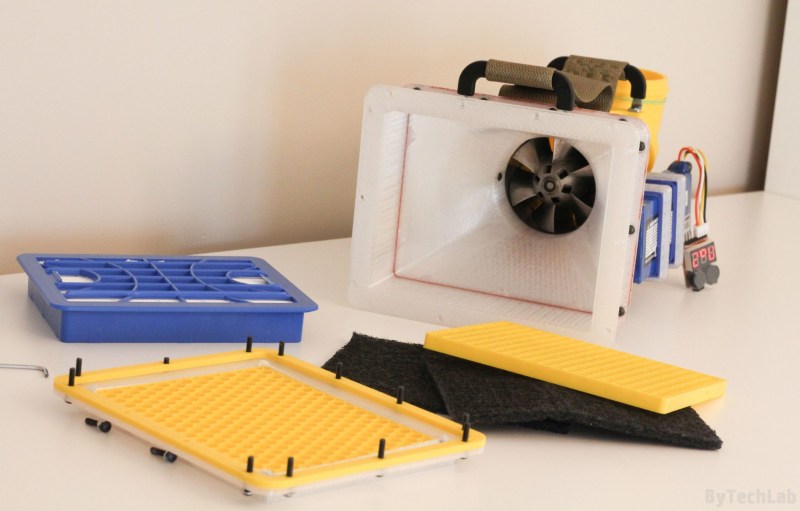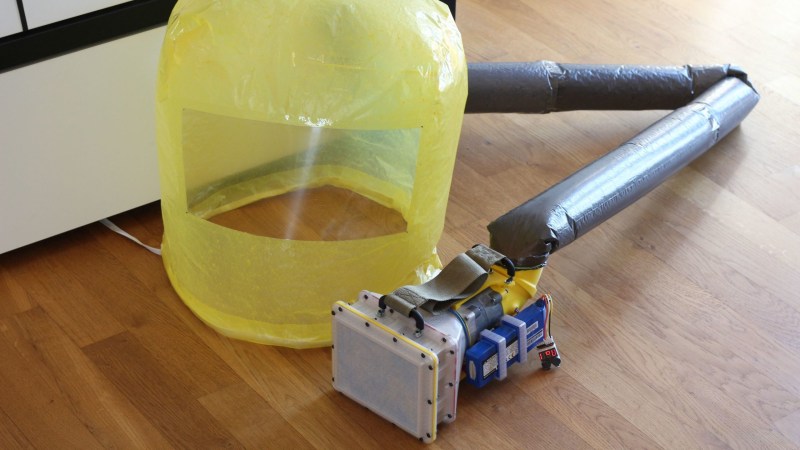[Andrew]’s Air filtering unit & positive pressure supply might look like something off the set of Ghostbusters, but it’s an experiment in making a makeshift (but feasible) positive pressure suit. The idea is to provide an excess of filtered air to what is essentially an inflatable soft helmet. The wearer can breathe filtered air while the positive pressure means nothing else gets in. It’s definitely an involved build that uses some specific hardware he had on hand, but the workmanship is great and shows some thoughtful design elements.
 The unit has three stacked filters that can be easily swapped. The first stage is medical mask material, intended to catch most large particles, which is supported by a honeycomb frame. The next filter is an off-the-shelf HEPA filter sealed with a gasket; these are available in a wide variety of sizes and shapes so [Andrew] selected one that was a good fit. The third and final stage is an activated carbon filter that, like the first stage, is supported by a honeycomb frame. The idea is that air that makes it through all three filters is safe (or at least safer) to breathe. There isn’t any need for the helmet part to be leakproof, because the positive pressure relative to the environment means nothing gets in.
The unit has three stacked filters that can be easily swapped. The first stage is medical mask material, intended to catch most large particles, which is supported by a honeycomb frame. The next filter is an off-the-shelf HEPA filter sealed with a gasket; these are available in a wide variety of sizes and shapes so [Andrew] selected one that was a good fit. The third and final stage is an activated carbon filter that, like the first stage, is supported by a honeycomb frame. The idea is that air that makes it through all three filters is safe (or at least safer) to breathe. There isn’t any need for the helmet part to be leakproof, because the positive pressure relative to the environment means nothing gets in.
Air is sucked through the filters and moved to the helmet by an HP BLc7000 server fan unit, which he had on hand but are also readily available on eBay. These fan units are capable of shoveling a surprising amount of air, if one doesn’t mind a surprising amount of noise in the process, so while stacked filter stages certainly impede airflow, the fan unit handles it easily. The BLc7000 isn’t a simple DC motor and requires a driver, so for reference [Andrew] has a short YouTube video of how the fan works and acts.
All the 3D models and design files are available online should anyone wish to take a closer look. It’s certainly a neat experiment in making a filtered positive pressure supply and head cover with materials that are fairly common. If [Andrew] ever wants to move to a whole-body suit, maybe repurpose an old Halloween costume into a serviceable positive pressure suit.
















What you need for this is a blower that can move a lot of air quietly. You can 3D print it…
https://drmrehorst.blogspot.com/2018/04/the-mother-of-all-print-cooling-fans.html
Yes, or any COTS centrifugal blower. Do not equate blower CFM ratings with fan CFM ratings either, when there’s any amount of resistance, a blower with “only” 25 cfm is gonna move a lot more air through something than a 90cfm fan that is incapable by design of developing any static pressure worth speaking of.
I’m not seeing any specs on the fan, nor the static pressure, rpm or CFM while pulling air through that load, nor on the resulting air pressure nor CFM through the “suit”. Am I blind or are those not provided?
What about filtration to protect the environment from an infected wearer?
I did not put this comment in this location. It was entered at the bottom of all of the comments as a new comment. What decided to insert it here?
I wonder where it will put this coment?
Hey Mark, really interesting your blog. Nice stuff, I’m sorry for you TT however.
Thanks and thanks, I really liked that car! I replaced it with a…. PRIUS!
Yeah, but does it have a little hole in the top so you can drink a beer while wearing it?
https://y.yarn.co/12fbfbc9-a845-4562-a88b-10de6b08f0a4_screenshot.jpg
Dude, your mom is an alcoholic.
Man, I love Sunny :D
I did some work on this decades ago. Not with an arduino controlled brushless motor of course. The real fun starts when you live in an arctic climate and add some batteries and a controllable 12 volt “rv” hair dryer or two for heat and a backpack and make what amounts to a full body space suit using some painting tyvek coverall things.
Suddenly -20F weather is comfy, heavy, but comfy. Its tricky to get enough air flow to the mask that it doesn’t fog up or condense yet doesn’t blow air in your eyes which makes them water.
We’re having a hot spell at the moment so I’m eyeing up the Koolatron….
(Has a peltier sandwiched in a heatsink with a hot and cold side, you can run them forwards or backwards, so can make the blower blow cold. If you get desperate for AC, fill one up with ice and water and put it on keep warm mode)
Much easier and more direct to carry a block of ice than the heavy battery + peltier. Peltier has the hot side to worry about.
Probably.
Though, what is more highly effective than is realised is the technique of rolling absorbent cloth, wetting it and hanging it round your neck. It sits over major blood vessels to the brain and provides evaporative cooling. You don’t feel it instantly, takes about half an hour before you notice.
There’s been all sorts of respins on this the last few years with gel beads and freezable packs and super fabrics, but plain old cotton does it. A well used tea towel is my recommendation.
Not sure if this was the idea behind neckerchiefs in the past, certainly dockers seem to have used “sweat rags” in the same way.
It’s also possible that the way vikings would have worn their hair, with braids emanating from the sweatiest part at the back of the head, then being brought in front, could have had similar effects. It also makes one wonder if the biblical story about Samson losing his strength after having his hair hut was based in the knowledge that hair could be used like this and in hot places you would overheat and be weak without the help.
I know I felt that effect back when I had long hair – but it only really works if you keep dunking your head in water or are sweating at the right rate.
When you are sweating so it just rolls off you then long hair is much cooler as it captures and forces the sweat to do its damn job and evaporate! But sweating less than that and its not so effective (not sure it feels any warmer having long hair never switched to short in a short timeframe under similarly hot conditions) – but will hold that ice cold water on your head and keep you cool for a good long while..
For me long hair was more effort than it was worth with extra looking after and having to be sure its tied out the way to avoid burnt hair on the soldering iron etc.. not to mention at some point its bound to fall out.
I like the Peltier idea being a small solid state heat and cold unit in one. Clearly inferior to just loading up with ice on the cooling for weight (assuming its battery powered), cool by cost and probably other factors.. But that its reverse-able and very controllable is quite handy, can see it being a practical option in some places.. That said I doubt I’d ever want a heating element – Shorts and T-shirt in the snow is perfectly comfortable for me. (Though its never hugely hugely cold here – but if freezing water temperatures and bare skin is comfy I expect jumpers and coats would prove enough for most places cold days)
Though the filling one up with ice comment was to mean using it unmodified as a stream of cool air to blow at you, the hot side is inside when you switch it to keep warm, so the ice is cooling the hot side and the cold side is blowing at you.
IF I were doing the suit the hot side would just be exposed to atmosphere with convective or forced air cooling off the sink. So the sink would still be a bit cumbersome, couple of pounds of aluminum. They only manage about a 40F differential though.
There was a guy 20 years ago that walked around Ormond Bch FL in a full spacesuit made of black garbage bags. I don’t know how he kept the helmet part “inflated” or how he didn’t die of heat stroke! He looked wacky and I’m sure someone somewhere has a picture, he would walk around near I-95.
He was ahead of the curve on keeping germs away, I’m sure if any got in the suit they cooked instantly!
“There isn’t any need for the helmet part to be leakproof, because the positive pressure relative to the environment means nothing gets in.”
Good for bringing sick to your Covid infected loved one.
Not acceptable as a mask substitute for socially responsible going out.
Not saying anyone said it was for that. Just thought it should be put out there before anyone has a bad idea.
And if he stands near the street in front of a furniture store or car dealership while bending up and down and flapping his arms, he’ll be able to sell a lot of merchandise!
More importantly: will it go through standard security checks. Worthless if it won’t.